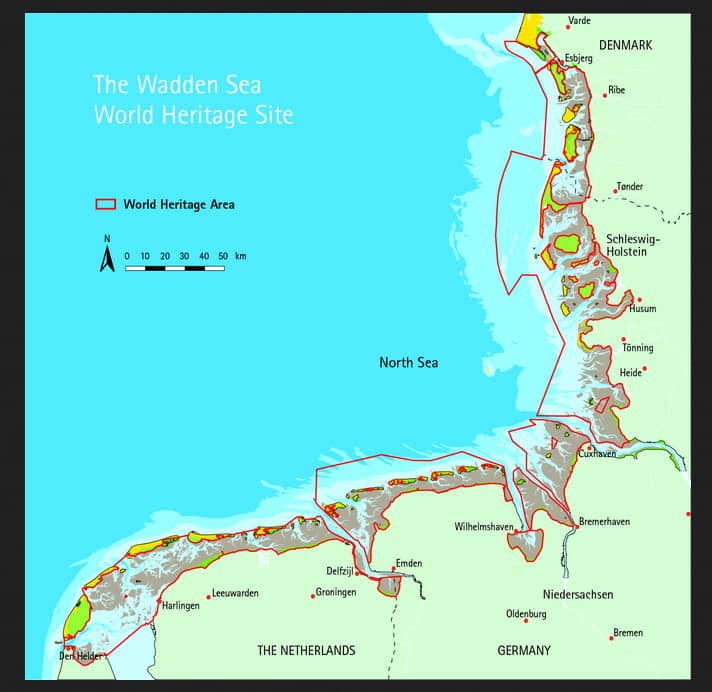
Sustainable sailing includes smart navigation, such as the capacity to simply stay clear of Particularly Sensitive Sea Areas (PSSA) with your boat wherever such areas are indicated on a nautical chart. The famous and beloved Wadden Sea, on the UNESCO World Heritage list since
2009, is an example of an equally beautiful as vulnerable marine reserve.
According to UNESCO, it is “one of the last remaining large-scale, intertidal ecosystems where natural processes continue to function largely undisturbed”. Reason why part of that region is closed for pleasure craft or commercial traffic at all times. Other parts are navigable at certain times yet totally off-limits at others. The trick with cruising in or near such protected areas of course is to have a clear picture about where you can sail with your ship without causing damage – and how to move once you take a walk at land.
A planet-friendly sailor is a well informed sailor! So for leisure charts covering the Dutch Wadden region where such protected areas would show up as clearly designated zones, see chart #1811 for the Western part and #1812 for the Eastern part of the Wadden Sea. Available here and at many other vendors (most marina shops have those charts, too). Quote from their website: “The 1800-series charts are issued mainly for smaller SOLAS shipping (Safety Of Life At Sea) and recreational
purposes. The series consist of 8 atlases with an average of 9 charts (loose-leaf). The charts cover the Netherlands and Belgian coasts, the Wadden Sea, the IJsselmeer and the Zeeland delta area.” Also definitely worth a read is the Code of honour for aquatic sports in the Dutch Wadden
region published by Dutch ocean wildlife shelter Ecomare. Therein, they advise on sensible behaviour in the sanctuary zones.

One of the beautiful educational posters offered by the Common Wadden Sea Secretariat, the above is a screenshot from the download section. To get your own free copy of that poster and much more, click here!
What’s so special and vulnerable about the Wadden Sea nature?
It features a unique and exceptionally fine-tuned marine and terrestrial ecosystem. Some areas there serve as important stopover for millions of migratory birds on their journey towards South and back to our Northern regions, as well as breeding ground. The same area is also vital, among other, for the (prevalently: harbour) seals living on and near the Wadden islands. The Dutch Common Wadden Sea Secretariat has a great informative website about the Wadden area, in 3 languages including English. It includes a section about sustainable tourism there. You have many options for fantastic nature sightseeing tours, water or land based, at the Wadden Sea. Some of them are guided excursions, highly recommended. With or without traditional Dutch sailing ships. The sustainable tourism section presents a selection of these.

Here is a fact that many sailors with best intentions are still totally unaware of:
The problem with humans interfering with nature in this region (and many others) is not just about stirring up some of those cute, heart-warming fat seals from their lazy sleep in the sun. Or chasing a birdie away from its place so that it can land a few metres further down the beach – and possibly laugh at your dog. Also, it won’t make any difference if you “move especially slowly and “carefully”.
Much more is at stake if humans get near the animals. Example seals, here is a very clear explanation what really can go terribly wrong when we disturb the seals at their nursing places (highlighting done by me):
“When a mammalian mother gives birth there is an immediate post natal bonding period during which there is an exchange of tactile, olfactory or auditory stimuli between mother and infant which establishes the initial bond between them. Pinniped mothers all give birth on shore and therefore this bonding occurs onshore. Harbour seal mothers and pups have a post natal bonding period of up to an hour or so during which there is repeated and reciprocal nose to body contact (Lawson & Renouf 1985; S. Wilson unpublished data). Human disturbance during this critical period may cause flushing of mother or both mother and pup into the water. The pup may be left behind as the mother and neighbouring seals re-enter the water, or there may be confusion of mother neonate identity in the water. Disturbance during this critical post-natal period is likely to lead to failure of mother pup bonding and therefore permanent separation of the pup.

Pup vocalisations are individually distinct and also critical to maintaining contact between mother and pup in the water and for facilitating reunion if mother and pup become separated.
KNRM, the Dutch Liefeboat people, rescuing a baby seal which was found alone at sea, clinging to a buoy. It was only 2 days old and very “skinny”. KNRM brought it to a seal nursery centre at Dutch Pieterburen.